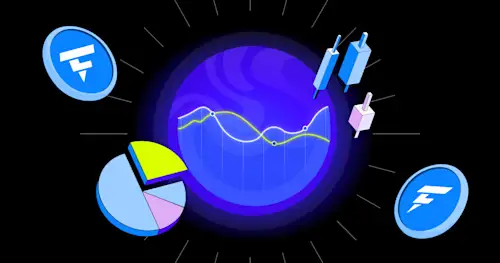相关文章




Cryptocurrency trading is as much an art as it is a science. While fundamental analysis can provide a macroeconomic view, it's technical analysis (TA) that traders rely on for short-term insights and decision-making. Whether you're a beginner aiming to understand price charts or a seasoned trader optimizing your strategies, the right technical analysis tools and indicators can be game-changing.
In this article, we examine the top 10 crypto technical analysis tools and indicators that every trader should be familiar with, encompassing both platform-based tools and standalone indicators. These are essential for identifying market trends, spotting potential entry/exit points, and minimizing trading risk.
TradingView has established itself as the premier charting and technical analysis platform for crypto traders of all levels. Renowned for its intuitive user interface and powerful functionality, it provides a comprehensive suite of tools that cater to both novice and professional traders. One of its strengths lies in its real-time access to cryptocurrency market data, enabling users to monitor price action across thousands of trading pairs with precision.
Beyond charting, TradingView offers Pine Script, a proprietary scripting language that allows traders to develop and implement their custom indicators and trading strategies. This flexibility empowers users to tailor their analytical environment to fit their personal trading style. Additionally, the platform’s vibrant social community enhances the learning experience—traders can publish, share, and discuss strategies, gaining insights from a global network of analysts and enthusiasts.
Overview: The RSI is a momentum oscillator that measures the speed and change of price movements. It oscillates between 0 and 100.
Key Trading Signal:
RSI > 70: Market is overbought (possible reversal)
RSI < 30: Market is oversold (possible bounce)
Overview: Moving averages help identify the general direction of a trend. The Exponential Moving Average (EMA) places more weight on recent prices than the Simple Moving Average (SMA).
Popular Settings:
50-day and 200-day MA for long-term trends
9-day and 21-day EMA for short-term momentum
Overview: The MACD shows the relationship between two EMAs (typically 12- and 26-day), along with a signal line. It helps traders understand trend direction and momentum.
Key Signal:
MACD line crossing above signal line: Bullish
MACD line crossing below signal line: Bearish
Overview: Bollinger Bands consist of a middle SMA and two outer bands based on standard deviation. They expand and contract with volatility.
How to Use:
Price touching upper band: Overbought
Price touching lower band: Oversold
“Bollinger squeeze”: Precursor to high volatility breakout
Overview: Volume Profile shows traded volume at different price levels rather than over time, revealing significant support/resistance zones.
Key Concepts:
High Volume Nodes (HVNs): Areas of price agreement
Low Volume Nodes (LVNs): Areas of potential breakout
Overview: Fibonacci retracement levels (e.g., 38.2%, 50%, 61.8%) help traders anticipate areas of potential reversal based on historical price movements.
Use Case:
Drawn from swing highs to lows to identify pullbacks
Commonly used with trend continuation strategies
Overview: OBV combines price and volume to identify the strength of price trends. It adds volume on up-days and subtracts on down-days.
Signal Type:
Rising OBV confirms uptrend
Falling OBV confirms downtrend
Divergence may indicate reversal
On-chain indicators offer traders a powerful and often underutilized edge by providing direct insights into blockchain data—information that reflects actual user behavior rather than just price movements. Unlike traditional technical indicators, which rely solely on price and volume, on-chain metrics analyze real-time transactional and behavioral data on the blockchain, helping traders anticipate market trends before they manifest in charts.
These tools track a variety of critical metrics. Exchange inflows and outflows reveal whether large amounts of cryptocurrency are being moved onto or withdrawn from exchanges, which can signal upcoming selling pressure or accumulation. Miner reserve balances provide insight into the supply side of the market; significant changes in miner holdings may indicate strategic decisions by those who control a substantial portion of new coin issuance. Meanwhile, whale transaction alerts monitor movements of large sums by major holders, offering clues about institutional activity or high-net-worth individual behavior.
Platforms like CryptoQuant, Glassnode, and IntoTheBlock have made these insights accessible with user-friendly dashboards and customizable alerts, enabling traders to spot shifts in market sentiment, liquidity risk, and supply dynamics with greater accuracy. As the crypto market becomes more mature and data-driven, integrating on-chain analysis into trading strategies is becoming increasingly essential for gaining a holistic view of market conditions.
Overview: Ichimoku Kinko Hyo provides a comprehensive view of support/resistance, momentum, and trend direction using multiple lines and a cloud structure.
Components:
Tenkan-sen and Kijun-sen: Short- and mid-term trend lines
Senkou Span A/B: Form the “cloud”
Chikou Span: Lagging line for confirmation
There’s no one-size-fits-all tool in crypto trading, as the effectiveness of technical indicators often depends on individual trading styles and objectives. Day traders may favor indicators such as RSI, MACD, and Bollinger Bands for identifying short-term price movements, while swing traders and long-term investors might find greater value in tools like volume profiles, moving averages, and on-chain analytics for assessing broader market trends. Utilizing a combination of 2–3 complementary indicators, conducting backtests with platforms such as TradingView, and incorporating both market fundamentals and sentiment analysis can contribute to more informed and balanced trading decisions.
Disclaimer: This material is for information purposes only and does not constitute financial advice. Flipster makes no recommendations or guarantees in respect of any digital asset, product, or service. Trading digital assets and digital asset derivatives comes with a significant risk of loss due to its high price volatility, and is not suitable for all investors. Please refer to our Terms.


